Powderpuff Tree: Flowers, Leaves (Pictures) – Identification and Care

The powderpuff tree is a tropical and subtropical flowering shrub or small tree famed for its whimsical red, pink, or white flowers. It’s an evergreen tree that gets its common name from its unique mimosa-like flowers resembling fluffy powder puffs. The powderpuff tree has a vase-like habit with glossy, dark green, silky leaflets that create feathery foliage.
The powderpuff tree is popular in southern gardens for its striking, spherical, pink or red puffy flower clusters. Its vibrant colors and unique floral display add a touch of exotic beauty to landscapes. Additionally, its relatively low care needs and low height make it an appealing choice for garden enthusiasts.
This article is an identification guide to the unique features of the powderpuff tree. Descriptions and pictures of the tree’s fluffy pinkish-red flowers, fern-like leaves, and growth habits will help you identify this beautiful and distinctive flowering tree.
What is a Powderpuff Tree?
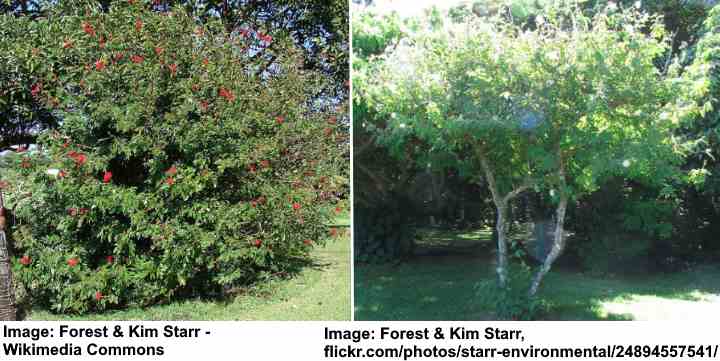
Powderpuff trees can have a form of large shrubs (left) or small trees (right)
The powderpuff tree is a small evergreen tree or large shrub in the bean family and genus Calliandra. Native to South and Central America, the tree features puffball-like flowers, pinnate compound evergreen, feathery leaves, and flattened, bean-like brown seed pods. Powderpuff trees bloom in fall and winter, and their flowers have a fragrant scent.
Powderpuff trees thrive in USDA zones 9 to 12 in full sunshine, retaining their foliage throughout the year. Its botanical name—Calliandra haematocephala—refers to the flower’s many stamens and blood-red color. It’s also called the fairy duster tree.
Some varieties of powderpuff trees, like the ‘Alba’ cultivar, have white puffball flowers.
Powderpuff trees are popular ornamental trees in central and southern Florida. Its native climate of South America is warm and humid. Therefore, it’s well suited to Florida landscapes. It also performs well as a flowering tree in the dry tropical and subtropical climates of Texas and Arizona.
Powderpuff Tree Flowers
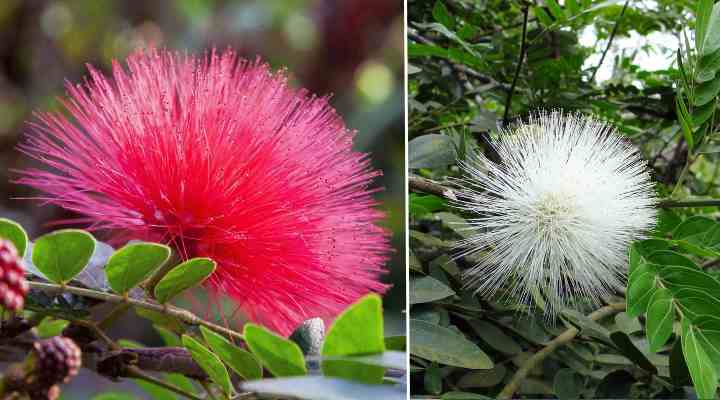
Powderpuff flowers can be red, pink or white
Powderpuff flowers are the most enchanting aspect of trees in the Calliandra genus. The puffball blooms boast distinctive, spherical flower heads resembling fluffy powder puffs. Each floret has prominent silky red, pink or white stamens, creating the powderpuff effect. The flower buds look like small raspberries.
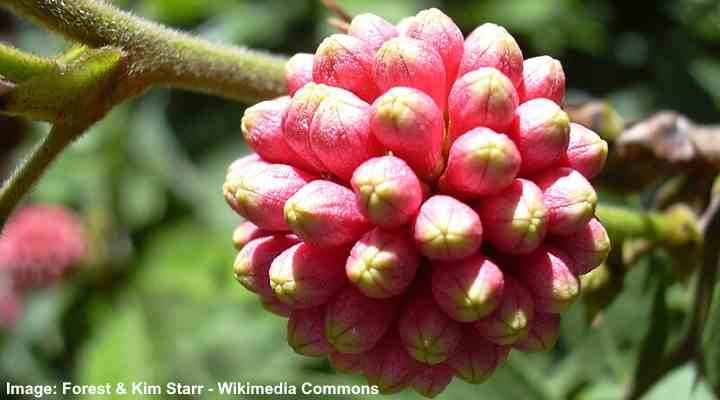
A close up picture of powderpuff flower buds
Powderpuff Tree Identification
Identifying the powderpuff tree is easy due to its distinctive red or pink flowers resembling powder puffs. The evergreen tree’s other features are its bipinnately compound leaves with up to ten pairs of leaflets on a single petiole. The small decorative, multi-stemmed, fast-growing tree reaches 15 ft. (4.5 m) tall and wide.
In the landscape, the powderpuff tree looks like a large shrub with numerous branches, a vase shape, and a rounded to flat top. The tree’s overall appearance and ornate floral display set it apart in garden landscapes. It is one of the most easily recognizable ornamental trees in southern gardens.
Powderpuff Tree Identification Features — Flowers, Leaves, and Fruit
Let’s look in detail at individual features to identify powderpuff trees.
Powderpuff Tree Leaves

Leaves on a powderpuff tree are feathery, bipinnately compound, and lush green. Each leaf comprises ten to 20 small oblong leaflets arranged along a petiole. The delicate, fern-like leaves measure 2” to 4” (5 – 10 cm) long. Powderpuff tree leaves emerge coppery-pink and mature to dark green. The evergreen leaves retain their lush color throughout the year.
An unusual feature of powderpuff tree leaves is how the leaves fold up at night. The dark green leaves create welcome shade in Florida’s hot, humid climate. They also contrast nicely with the delightful pinkish-red to deep-red puffball blossoms.
Powderpuff Tree Blooms

Flowers on powderpuff trees measure 2” to 3” (5 – 7.5 cm) across and bloom in fall and winter. Each flower consists of densely packed buds resembling raspberries. The soft, fuzzy flowers develop when numerous blood-red stamens emerge. These create visually striking scarlet blooms resembling flowers on mimosa plants.
The red powderpuff flowers give the small tree a fuzzy appearance, adding to its ornamental value in southern gardens. Growing small powderpuff shrubs or trees enhances biodiversity in garden landscapes. The fragrant, sweetly-scented blooms attract pollinators like butterflies, bees, and hummingbirds. Thanks to the beautiful puffy flowers, the trees are vital for local ecosystems.
Powderpuff Tree Bark

The powderpuff tree typically has a smooth and grayish-brown bark when young. As it matures, the bark becomes slightly furrowed and more textured. The bark may become darker with age. While not a prominent feature, the bark serves as a protective outer layer for the tree’s trunk and branches.
Powderpuff Tree Size and Appearance
The powderpuff tree grows as a medium-sized evergreen shrub or small tree. Its mature height is 10 to 15 ft. (3 – 4.5 m). It features an upward-spreading vase shape with a rounded canopy. Its finely divided, fern-like leaves and fuzzy spherical flower clusters give the tree a striking appearance in landscapes.
One of the reasons the powderpuff tree is popular is because it’s easy to prune. Many gardeners grow the tree as an ornamental shrub. It’s easy to maintain its height at 4 to 6 ft. (1.2 – 1.8 m) and use it for shrub borders, foundation planting, small lawn trees, or specimen plants.
Powderpuff Tree Growth Rate
The powderpuff tree has a fast growth rate, gaining 2 to 3 ft. (0.6 – 0.9 m) in height annually. Under optimal conditions, its rapid growth means it quickly fills spaces, becoming a beautiful ornamental specimen tree in gardens. The powderpuff tree can add to a lush and vibrant landscape in a relatively short time.
Powderpuff Tree Fruit
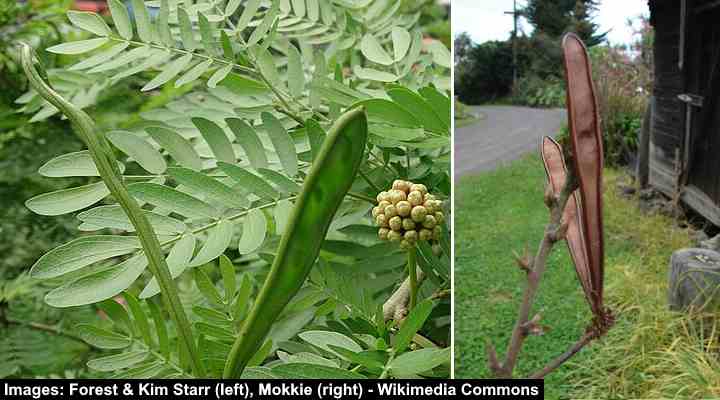
Powderpuff seed pods: immature green seed pods (left) and mature brown ones (right)
Powderpuff trees produce small, inconspicuous fruits or seed pods after flowering. The powderpuff seedpods are identified by their flattened, elongated hard cases, each containing several pea-like seeds. The brown seed pods measure 3” to 6” (7.5 – 15 cm) long. While not as ornamental as its vibrant flowers, the seeds are a food source for wildlife.
Powderpuff Tree Care
Fast-growing powderpuff trees have minimal care requirements when established. They thrive in sandy, well-draining, moist soil in full sunlight. During the hottest months, the puffball trees require regular watering to keep the soil moist. With ideal care, the powderpuff trees can bloom throughout the year. They are generally easy-care ornamental trees.
Let’s look at how to care for powderpuff trees in more detail.
Soil type
Powderpuff trees grow best in well-draining soil with a pH level of between 6.0 and 7.5. However, the decorative trees are adaptable and can tolerate various soil types, including poor, sandy, or nutrient-deficient soils. The most crucial care factor is proper drainage because their roots don’t tolerate overly soggy soil.
Sun requirements
Powderpuff trees thrive in full sunlight. Plant the trees in a sunny location with six to eight hours of direct sunlight daily. Ample sunlight ensures the tree blooms profusely through fall and winter. In ideal conditions, it occasionally produces flowers throughout the year. In the hottest regions, the trees tolerate partial shade or filtered sunlight in the afternoon.
Temperature and humidity
Powderpuff trees thrive in USDA zones 9 to 12, native to tropical and subtropical regions. Therefore, the trees perform best in warm temperatures and high humidity levels. A temperature range of 60°F to 80°F (15°C – 27°C) and humidity of 50 to 70 percent are ideal to keep them healthy.
In colder climates, it’s best to grow powderpuff trees in containers. This way, you can bring them indoors during the winter months. It’s important to note that powderpuff trees are not frost-tolerant. Temperatures that drop below freezing can cause damage to the tree’s leaves and roots.
Watering needs
Powderpuff trees have moderate watering needs. During the growing season, it’s vital to provide regular water to keep the well-draining soil moist. However, let the top 1” to 2” (2.5 – 5 cm) of soil dry out between watering. This ensures the tree’s roots have enough moisture without becoming waterlogged.
Water the tree deeply once a week, ensuring the water reaches the root zone, which is 6” to 8” (15 – 20 cm) deep. This watering schedule encourages healthy root development and helps the tree withstand dry spells. However, during heat or extended dryness, increase the watering frequency.
Mulching around the powderpuff tree’s base can help retain moisture in the soil and reduce weed growth. Apply a 2” (5 cm) layer of organic mulch, such as wood chips or bark, around the root zone. However, remember to leave a 4” or 5” (10 – 12.5 cm) gap from the trunk to prevent rotting.
Fertilizer
Regular fertilization can promote healthy growth and abundant blooms on powderpuff trees. You can apply a balanced, slow-release fertilizer specifically formulated for flowering trees. Ideally, a tree fertilizer with an NPK ratio of (10-10-10 or 14-14-14 is ideal. This provides a good balance of essential nutrients to promote healthy foliage and blooming.
It’s good to remember that powderpuff trees can perform well in poor soils if they get enough water. Therefore, working compost or well-rotted manure into the root zone in early spring is enough to keep tree growth healthy.
How to Use Powderpuff Tree in Landscapes
Powderpuff trees add a splash of vibrant color to sunny landscapes. The eye-catching red or pink puffy flowers and delicate foliage create focal points and enhance the aesthetic of outdoor spaces. Powderpuff trees have uses in Southern landscapes. Here are a few ideas.
Focal point
Plant the powderpuff tree as a centerpiece in your garden or yard. Its vibrant flowers and unique foliage make it a visually striking focal point. It will draw attention and add interest to your front or backyard.
Border planting
Powderpuff shrubs are ideal for creating an evergreen border or hedge. Their dense growth habit and lush foliage stay green throughout the year. This makes it ideal for creating a natural and colorful privacy screen or security barrier in your landscape.
Container planting
Powderpuff trees are ideal for container planting. You can grow the multi-stemmed shrubs in large pots and place them on a patio or decking area. In colder climates, you can bring them indoors during winter. The benefit of growing powderpuff trees in containers is that they remain a small, compact size—ideal for gardens with limited space.
Plant spacing
If you plan to plant a powderpuff tree on its own, leave a gap of 10 ft. (3 m) between other large shrubs. This allows you to enjoy its splendor as the flowering tree fills your landscape with vibrant pink and red shades. However, plant the trees 4 to 5 ft. (1.2 – 1.5 m) apart to create a barrier or hedge.
How to Propagate Powderpuff Trees
You can propagate powderpuff trees two ways—from seed or stem cuttings. Here are instructions on how to grow powderpuff trees.
Powderpuff tree propagation from seed:
- Take some powderpuff tree seeds in early spring and scarify them by gently scratching the outer coating.
- Pour hot water over the seeds and let them soak for 24 hours.
- Plant the seeds in a seed-starting mix and cover them lightly with soil.
- Cover the seed tray and put it in a warm, bright location.
- Maintain temperatures between 70°F and 75°F (21 – 24°C) and keep the soil moist.
- Wait one to three weeks for the seeds to germinate.
- Once a few leaves are on the seedlings, you can transfer the plants to a sunny place in your garden.
Powderpuff tree propagation from stem cutting:
- Choose semi-hardwood cuttings 4” to 6” (10 – 15 cm) long from the tips of healthy branches. These cuttings should have a few leaves and be free from flowers.
- Make clean, angled cuts just below a node and remove leaves from the cutting’s lower part.
- Dip the cut end of each stem into rooting hormone powder
- Insert the cuttings 2” (5 cm) deep into small pots filled with well-draining potting mix.
- Water the cuttings thoroughly, allowing excess water to drain.
- Cover the tray or pots with a clear plastic bag to create a humid environment and place in bright, indirect sunlight.
- Mist the cuttings regularly to increase humidity.
- Once rooted, plant the cuttings in the sunniest part of your front or backyard.
How to Grow Powderpuff Tree Indoors
Powderpuff trees grow well in containers indoors. You should grow the potted shrub in well-drained, fertile soil. Place it in bright, indirect sunlight, where it gets at least six hours of light daily. Water when the top inch (2.5 cm) of soil is dry, allowing excess water to drain from the holes in the base.
Keep even temperatures of 60°F to 70°F (15.5°C – 21°C) and ensure humidity is at least 50 percent. Always keep the indoor tree away from drafts.
Powderpuff Tree Pests and Diseases
Powderpuff trees are usually pest-free, although they can be occasionally infested by chewing insects such as caterpillars and spider mites. These trees also don’t have diseases that are of major concern, however overly watering the powderpuff tree can cause root rot.
Types of Powderpuff Trees
Pink Powderpuff Tree (Calliandra emarginata)

The pink powderpuff tree is a stunning small tree with delightful, puffy pink flowers. The small flowering plant grows up to 20 ft. (6 m) tall and wide. Its evergreen leaves are evergreen, pinnate, and composed of several pairs of small leaflets. The pink flowers grow 1” to 2.3” (6 cm) across.
White Powderpuff Tree (Calliandra haematocephala’ Alba’)

The white powderpuff tree features white or cream-colored spherical puffball blooms. It’s an unusual powderpuff tree because it doesn’t have typical pink or red flowers. The shrub-like tree grows up to 6.5 ft. (2 m) tall and wide. The dark green foliage contrasts nicely with the fluffy white flowers, creating an eye-catching shrub in gardens and landscapes.
Red Powderpuff Tree (Calliandra haematocephala)

The red powderpuff tree is a tropical evergreen shrub or small tree with deep-red puffball blooms. The shrub-like tree has a vase shape with an open crown. Its pinnate compound leaves measure up to 4” (10 cm) long, and its show fuzzy flowers measure 2” to 4” (5 – 10 cm) in diameter.
Dwarf Powderpuff Tree (Calliandra tergemina var. emarginata)
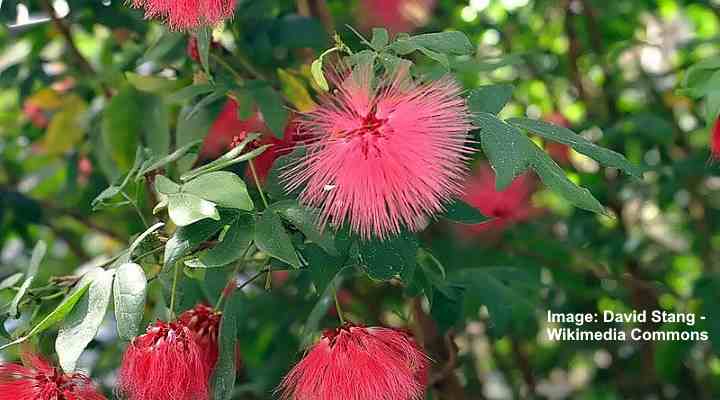
The dwarf powderpuff shrub-like tree doesn’t grow taller than 3 feet (0.9 m) tall. It has scarlet puffball blooms that flower throughout the year and more prolifically in winter. It’s an ideal ornamental shrub for small, compact gardens in Florida. The scarlet-red flowers measure 2” (5 cm) in diameter.
Baja Fairy Duster (Calliandra californica)

Native to Baja California, the Baja fairy duster is a red-flowering woody shrub that blooms from spring through fall. The bright red, fluffy flowers measure 1.5” (3.5 cm) and resemble feather dusters. The native powderpuff tree grows 5 to 6 ft. (1.5 – 1.8 m) tall and wide.
Related articles:
